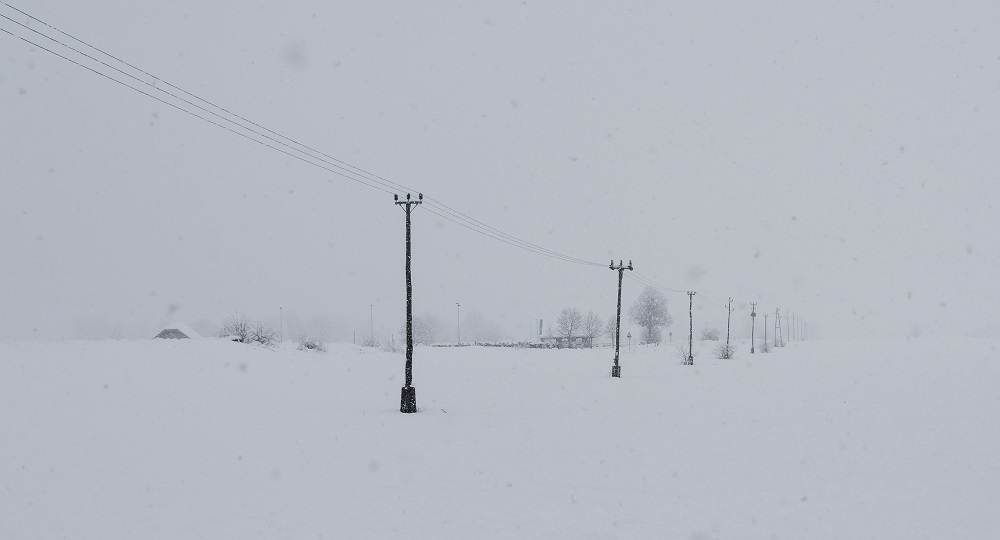With changing seasons every year, weather events that were once considered a rare occurrence are now increasingly commonplace. Across the globe, extreme weather is being considered the new normal. This includes:
- Record hurricanes
- Destructive wildfires
- Deadly heatwaves
- Torrential rains and flooding
- Intense winter storms
Climate crises are significantly impacting winter weather across the globe in many ways, including:
- Unpredictable weather: Climate change is altering atmospheric circulation patterns, making winters more unpredictable.
- Extreme Weather Conditions: Ongoing climate crises are increasing the severity of extreme weather events, like heatwaves, heavy rainfall, and droughts.
- Rising Sea Levels: Water levels are rising at an alarming rate due to climate change, which can cause flooding from storm surges to wash further inland.
- Changes to wind dynamics: Climate change is also changing wind dynamics, making them lighter.
Some other ways climate change affects the weather:
- Rapid melting of glaciers is contributing to rising sea-level rise.
- Climate change is expected to increase precipitation in many areas.
- Heat extremes and droughts are damaging crop production.
Read more: Developing an Effective ESG strategy: Best Practices for Businesses and Communities
Why is This Happening?
Human activity is driving rapid changes to the global climate that contribute to extreme weather conditions. When fossil fuels are burned for transportation and electricity, a greenhouse gas - carbon dioxide that traps solar radiation, is released into the atmosphere.
In the past century, massive rises in carbon dioxide, methane, and other greenhouse gases have caused the temperature to rise. This spike in global temperatures is further fueling climate disasters that are likely to worsen unless no strict actions are taken. Experts have also warned that we are running out of time to cut pollution in order to reduce climate catastrophe dramatically.
The Changing Face of Winter Weather
Once considered a season of predictable patterns and familiar chill, winter has become increasingly erratic, leaving communities around the globe grappling with unprecedented extreme weather conditions. From blistering cold to unseasonably warm spells, the variability of winter weather is sparking serious discussions about the role of climate change in shaping these fluctuations.

Rising global average temperature is associated with overall changes in weather patterns. Scientific studies have highlighted that extreme weather events like heat waves and large storms are likely to become more intense with human-induced climate change.
Impacts of Climate Changes to the Ecosystem
- Risk to water levels
- Conflict and climate migrants
- Localized flooding
- Damage to marine ecosystems
- Loss of biodiversity
- Heat stress
- Habitable region of pests expands
- Forest mortality and increased risk of forest fires
- Damage to infrastructure
- Food insecurity
Long-term climate crises can directly or indirectly affect multiple aspects of society in potentially disruptive ways.
- Warmer average temperatures can lead to a rise in air conditioning costs and affect the spread of diseases like Lyme disease. However, it could also enhance conditions for growing some crops.
- Frequent and extreme heat events can lead to a rise in illnesses and deaths, especially among vulnerable populations, as well as damage to some crops.
- Increased precipitation can replenish water supplies and support agriculture.
- Intense storms can damage property, cause loss of life, and temporarily disrupt essential services like transportation, telecommunications, and water supplies.
- More extreme variations in weather are a threat to society.
Read more: 2024 Guide: A Green World Through ESG Compliance
As the planet’s climate continues to warm due to human activities such as deforestation and the burning of fossil fuels, the dynamics of winter are undergoing a significant transformation.
-
Unprecedented Extremes
One of the most significant consequences of climate change on weather patterns is the intensification of extremes. In some regions, winters have become harsher, leading to record-breaking snowstorms and prolonged periods of cold weather. Conversely, other regions are witnessing milder winters, with reduced snowfall and higher temperatures.
-
Impacts on Society and Ecosystems
The erratic nature of winter poses significant challenges for society and ecosystems. Infrastructure, agriculture, and transportation systems are vulnerable to these extreme winter conditions. It further disrupts everyday life and leads to economic losses. Furthermore, fluctuating temperatures and precipitation patterns disrupt the ecosystems, affecting wildlife, migratory patterns, and biological events like hibernation.
-
Polar Amplification
Polar amplification is a key driver behind the erratic nature of winter. Greenhouse gas emissions get trapped in the atmosphere. At the same time, temperatures in the Arctic and Antarctic regions are rising faster than the global average. This warming destabilizes the polar jet stream, influencing weather patterns at mid-latitudes. The weakened jet stream can displace cold Arctic air masses southward, bringing frigid temperatures to regions that experience milder winters.
-
Shifts in Atmospheric Circulation Pattern
Climate change alters atmospheric circulation patterns, thus contributing to the unpredictability of winters. Changes in the atmosphere's distribution of heat and moisture further create a shift in the position and intensity of high and low-pressure systems. This influences the tracks of winter storms and the distribution of precipitation. This shift can also result in anomalous weather events like heavy snowfalls, prolonged droughts, or torrential rains.

-
Adapting to a Changing Climate
In the face of extreme winters, adaptation strategies are important for communities to mitigate the impacts of climate change. This involves investing in resilient infrastructure, implementing sustainable practices, and integrating measures to enhance early warning systems for extreme weather events. Measures need to be undertaken to reduce greenhouse gas emissions, minimize future disruptions, and hinder the rate of climate change.
Finding a Solution
Today, the world is feeling the urgency of climate deadlines and calling for action at a scale that matches the threat. There is a growing need for bold climate solutions to move towards a pollution-free and 100% clean energy future. Governments must collaborate with communities on the frontlines to tackle the climate crisis.
- Clearing the way for clean energy: It is critical to ensure that utilities, regulators, and grid operators do not discriminate against clean energy. They must consider energy markets that can prop up gas and coal and exclude independent clean energy generators.
- Electrifying the economy: Transportation generates more greenhouse gas emissions than other economic sectors. Measures must be integrated to promote and adopt zero-emission and electrifying locomotives and public buses.
- Centering regulations around environmental justice and expanding access to clean energy is important for every community. Protecting climate forests, promoting climate-smart agriculture practices, eliminating petrochemical buildout, and challenging polluted hydrogen and carbon capture projects can further assist in prolonging the use of fossil fuels.
The fight to preserve a livable planet connects everyone. Together, we can drive this transformative change and preserve our ecosystem.
Read more: Eco-friendly Buildings on the Rise: Why Building Products Matter
Conclusion
The destabilizing forces of climate change have upended once-predictable winter weather. Several factors driving winter variability are complex and multifaceted, from polar amplification to atmospheric circulation shifts. While communities globally are grappling with the challenges of an increasingly erratic winter climate, proactive measures need to be undertaken to adapt and mitigate the impacts of climate change. This will further help in building a more resilient future.
By identifying and addressing the root causes of the ongoing climate crisis and implementing adaptive measures, we can strive to safeguard society and nature from the unpredictable fury of winter.
A leader in ESG Services, SG Analytics offers bespoke sustainability consulting services and research support for informed decision-making. Contact us today if you are searching for an efficient ESG (Environmental, Social, and Governance) integration and management solution provider to boost your sustainable performance.
About SG Analytics
SG Analytics (SGA) is an industry-leading global data solutions firm providing data-centric research and contextual analytics services to its clients, including Fortune 500 companies, across BFSI, Technology, Media & Entertainment, and Healthcare sectors. Established in 2007, SG Analytics is a Great Place to Work® (GPTW) certified company with a team of over 1200 employees and a presence across the U.S.A., the UK, Switzerland, Poland, and India.
Apart from being recognized by reputed firms such as Gartner, Everest Group, and ISG, SGA has been featured in the elite Deloitte Technology Fast 50 India 2023 and APAC 2024 High Growth Companies by the Financial Times & Statista.









